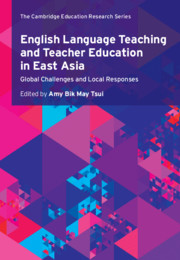Book contents
- English Language Teaching and Teacher Education in East Asia
- English Language Teaching and Teacher Education in East Asia
- Copyright page
- Contents
- Figures
- Tables
- Contributors
- Preface
- Acknowledgements
- 1 Glocalization and Grobalization: Critical Issues in English Language Teaching and Teacher Education in East Asia
- 2 Concepts of Globalization and English Language Teacher Education in Singapore
- 3 Learning to Teach English in Hong Kong: Transformation and Tensions Over Two Decades of English Language Teacher Education Policy
- 4 Meeting National Needs in English Language Teacher Education: Global Perspectives in Malaysian Initiatives
- 5 English Teacher Education in Postcolonial Philippines
- 6 China Going Global: Challenges and Responses in English As a Foreign Language Teaching and Teacher Education
- 7 English Education Reform, Teacher Education, and the Tokyo Olympics: Perfect Timing?
- 8 English Language Teacher Education in South Korea: Changes and Challenges
- 9 Preparing English Teachers in the Twenty-First Century: The Case of Taiwan
- 10 English Language Teacher Education in Thailand: A Mix of Global and Local
- 11 Interrogating Troubling Issues in Vietnam’s English Language Teacher Education
- Index
- References
5 - English Teacher Education in Postcolonial Philippines
Published online by Cambridge University Press: 17 October 2020
- English Language Teaching and Teacher Education in East Asia
- English Language Teaching and Teacher Education in East Asia
- Copyright page
- Contents
- Figures
- Tables
- Contributors
- Preface
- Acknowledgements
- 1 Glocalization and Grobalization: Critical Issues in English Language Teaching and Teacher Education in East Asia
- 2 Concepts of Globalization and English Language Teacher Education in Singapore
- 3 Learning to Teach English in Hong Kong: Transformation and Tensions Over Two Decades of English Language Teacher Education Policy
- 4 Meeting National Needs in English Language Teacher Education: Global Perspectives in Malaysian Initiatives
- 5 English Teacher Education in Postcolonial Philippines
- 6 China Going Global: Challenges and Responses in English As a Foreign Language Teaching and Teacher Education
- 7 English Education Reform, Teacher Education, and the Tokyo Olympics: Perfect Timing?
- 8 English Language Teacher Education in South Korea: Changes and Challenges
- 9 Preparing English Teachers in the Twenty-First Century: The Case of Taiwan
- 10 English Language Teacher Education in Thailand: A Mix of Global and Local
- 11 Interrogating Troubling Issues in Vietnam’s English Language Teacher Education
- Index
- References
Summary
This chapter discusses global challenges in English language teaching and teacher education and the local responses in the Philippines. It outlines the issues posed by globalization from two perspectives: (1) globalization as an "economic imperative" and (2) "critical resistance" against globalization as marginalizing local economic initiatives. It discusses the government’s responses to these issues, motivated by the need for the Philippines to be globally competitive, especially as part of a community of nations in the ASEAN. This chapter also discusses critical issues arising from the local responses to the challenges of globalization, which impact on English language teaching and teacher education in the Philippines: the competing proposals for the medium of instruction, the mixed attitudes toward English, the changing standards of English, and the expanding role of the English language teacher. Finally, it outlines important insights have been gained from these discussions that may inform policy making and professional practice.
Keywords
- Type
- Chapter
- Information
- English Language Teaching and Teacher Education in East AsiaGlobal Challenges and Local Responses, pp. 93 - 112Publisher: Cambridge University PressPrint publication year: 2020

